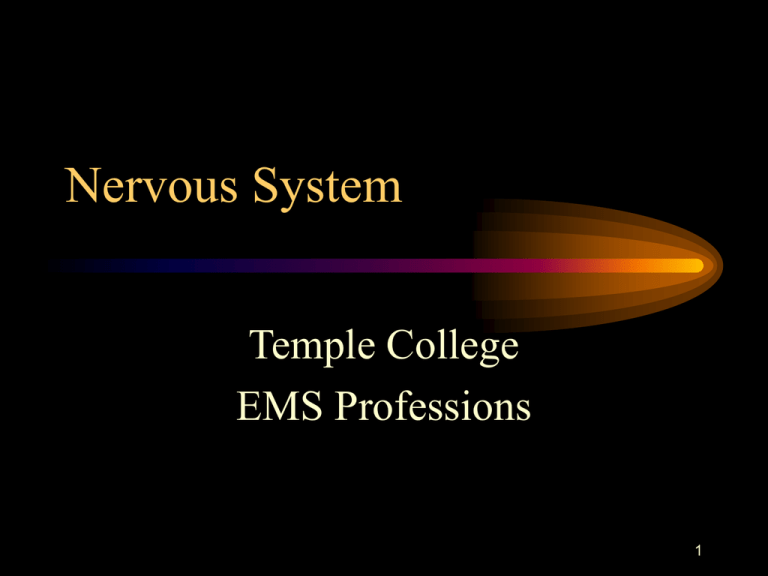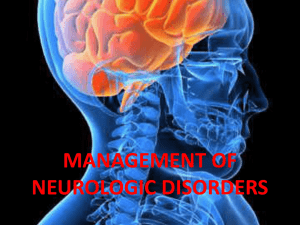Head and Spine Trauma
advertisement

Nervous System Temple College EMS Professions 1 Nervous System Components • Central Nervous System – Brain – Spinal Cord • Peripheral Nervous System – Motor nerves – Sensory nerves 2 Brain • Body’s controlling organ • Responsible for organizing functions of other body organ systems 3 Brain • Functions localized to specific areas – Cerebrum – Cerebellum – Brainstem 4 Cerebrum Center for conscious perception and response • Frontal lobe – Foresight, planning, judgment – Movement • Parietal lobe • Temporal lobe – Hearing – Speech • Occipital lobe – Vision – Sensation from body surface 5 Cerebrum Left side of cerebrum Sensory, motor functions of body’s left side Right side of cerebrum Sensory, motor functions of body’s right side 6 Cerebellum • • • • Posture Balance Equilibrium Fine motor skills 7 Brain Stem • Automatic functions below level of consciousness – – – – Heart rate Respirations Blood pressure Body temperature 8 Spinal Cord • • • • Connects brain with body Serves as center for reflex action Surrounded, protected by spinal column Damage cuts brain off from body structures distal to injury site 9 Peripheral Nerves Brain Spinal Cord Sensory Nerves Motor Nerves 10 Nervous System Autonomic Nervous System Voluntary Nervous System Unconscious (Visceral) Functions Conscious Functions 11 Brain/Spinal Cord • Enclosed in protective box – Skin – Muscle – Bone – Meninges 12 Meninges • Three layers of tissue enclosing brain, spinal cord – Dura mater – Arachnoid – Pia mater 13 Cerebrospinal Fluid (CSF) • Surrounds brain, spinal cord in space between arachnoid and pia mater (subarachnoid space) • Acts as a shock absorber • Protects brain from jolts, shocks 14 Injuries to Scalp and Skull • Scalp Lacerations • Skull Fracture 15 Scalp Lacerations • VERY vascular area • Can distract EMT from possible underlying injuries • Care for laceration, but ask, “WHAT HAPPENED TO BRAIN AND NECK?” 16 Scalp Lacerations • Bleeding usually NOT severe enough to produce hypovolemic shock • If shock present, think about other injuries • Exceptions – Laceration that involves a large artery – Scalp injuries in children. Why? 17 Skull Fractures • Injury to rigid box around brain • Indicates significant force • What happened to brain and neck? 18 Types of Skull Fracture • Linear – Most common – Crack in skull – Detected only on x-ray • Comminuted – Multiple cracks radiate from impact point 19 Types of Skull Fracture • Depressed – Bone fragments pressed inward – Places pressure on brain – Brain tissue may be exposed through injury • Basilar – Fractures in floor of skull – Diagnosis made clinically – Signs and symptoms • Periorbial ecchymosis (Raccoon eyes) • Battle’s sign • CSF drainage from nose, ears 20 Skull Fractures DO NOT TRY TO STOP FLOW OF BLOOD, FLUID FROM NOSE OR EARS MAY CAUSE INCREASED INTRACRANIAL PRESSURE AND BRAIN INFECTION 21 Injuries to Brain 22 Concussion • Temporary disturbance in brain function • Probably due to brain being “rattled” inside the skull by a blow to the head • Usually confused or unconscious • Retrograde amnesia--“What happened?” • Effects clear without residual effects 23 Cerebral Contusion • • • • Bruising, swelling Results from brain hitting skull’s inside Coup-contracoup pattern Since brain is in closed box, pressure increases as brain swells, blood flow to brain decreases 24 Cerebral Contusion • Signs and Symptoms – Personality changes – Loss of consciousness – Paralysis (one-sided or total) – Unequal pupils – Vomiting 25 Epidural Hematoma • Usually associated with skull fracture in temporal area • Fracture damages artery on skull’s inside • Blood collects in epidural space between skull and dura mater • Since skull is closed box, intracranial pressure rises 26 Epidural Hematoma • Signs and Symptoms – Loss of consciousness followed by return of consciousness (lucid interval) – Headache – Deterioration of consciousness – Dilated pupil on side of injury – Weakness, paralysis on side of body opposite injury – Seizures 27 Subdural Hematoma • Usually results from tearing of large veins between dura mater and arachnoid • Blood accumulates more slowly than in epidural hematoma • Signs and symptoms may not develop for days to weeks 28 Subdural Hematoma • Signs and Symptoms – Deterioration of consciousness – Dilated pupil on side of injury – Weakness, paralysis on side of body opposite injury – Seizures Because of slow or delayed onset, may be mistaken for stroke 29 Cerebral Laceration • Tearing of brain tissue • Can result from penetrating or blunt injury • Can cause: – Massive destruction of brain tissue – Bleeding into cranial cavity with increased intracranial pressure 30 Assessment of Head Injury • Early detection of increased intracranial pressure is critical • If pressure inside skull exceeds average blood pressure, blood flow to brain stops • Increasing intracranial pressure can force brain downward into spinal canal, crushing it 31 Assessment of Head Injury • Level of consciousness is BEST indicator of patient’s condition – AVPU system – Glasgow scale 32 AVPU System • • • • Alert Responds to Verbal Stimulus Responds to Painful Stimulus Unresponsive 33 Glasgow Scale • Eye Opening – – – – • Verbal Response Spontaneous = 4 To Voice = 3 To Pain = 2 None = 1 – Oriented = 5 – Confused = 4 – Inappropriate Words = 3 – Incomprehensible Sounds = 1 – None = 1 • Motor Response – Follows Commands = 6 – Localizes Pain = 5 – Withdraws = 4 – Flexion = 3 – Extension = 2 – None = 1 Score each response then total scores Maximum Score = 15 Minimum Score = 3 34 Assessment of Head Injury • Vital Signs – Body responds to increasing intracranial pressure by raising BP – Increased BP moves blood into brain against rising ICP – Heart rate falls in response to rising BP 35 Cushing’s Triad Increased BP Altered Breathing Slow Pulse 36 Vital Signs Isolated head injury does not cause hypotension or tachycardia! Signs of shock in head injured patient indicate other injuries are present! 37 Pupils • Diffuse cerebral edema – Dilated – Equal – Sluggish or absent response 38 Pupils • Focal lesion (contusion, hematoma) – Unequal – Dilated pupil sluggish or fixed Dilated pupil is on SAME side as injury 39 Assessment of Head Injury • Other Indicators of Increased ICP – Headache – Nausea – Vomiting (often projectile) – Seizures 40 Management of Head Injury • ABCs with C-spine control • C-collar, long board, CID Any patient with significant head injury has neck injury until proven otherwise • Ensure adequate oxygenation • If signs of increased ICP present, controlled hyperventilation with BVM at 20-24 breaths/minute 41 Management of Head Injury • Controlled hyperventilation – – – – Lowers blood carbon dioxide levels Causes constriction of blood vessels in brain As vessels constrict brain shrinks As brain shrinks intracranial pressure drops 42 Management of Head Injury • Do NOT apply pressure to open or depressed skull fractures • Do NOT attempt to stop flow of blood or CSF from nose, ears • Do NOT remove penetrating objects 43 Spinal Injuries 44 Significance • Spinal injury can lead to spinal cord injury • Spinal cord injury can lead to: – Paraplegia – Quadraplegia 45 Most important spinal injury indicator… MECHANISM 46 Common Mechanisms • • • • Compression Flexion Extension Rotation • Lateral bending • Distraction • Penetration 47 Suspect spinal injury with... • Sudden decelerations (MVCs, falls) • Compression injuries (diving, falls onto feet/buttocks) • Significant blunt trauma above clavicles • Very violent mechanisms (explosions, cave-ins, lightning strike) 48 Significant Head Injury = Neck Injury Until Proven Otherwise 49 Other indications • • • • Decreased LOC in trauma patient Pain in spine or paraspinal area Pain in back of head, shoulders, arms, legs Absent, altered sensation (numbness, paresthesias, loss of temperature, position, touch sense) • Absent, altered motor function (weakness, paralysis) 50 Other indications • • • • Diaphragmatic breathing (paralysis of chest wall) Shock with slow heart rate and dry skin Incontinence Priapism 51 Or, there may be no signs at all. . . • Neurologic deficits are a result of cord injury • Spinal injury without cord involvement may produce no significant signs and symptoms 52 Management • • • • ABCs with C-spine control Ensure adequate oxygenation, ventilation Keep ENTIRE spine immobilized Repeatedly assess, document neurologic status: – Position sense – Pain – Motion • Repeatedly monitor respirations, blood pressure 53 Spinal Trauma Complications • Respiratory Failure – Chest wall innervated from thoracic spine – Diaphragm innervated from C3,4,5 via phrenic nerve – Cord injury can produce paralysis of respiratory muscles, lead to ventilatory failure 54 Spinal Trauma Complications • Neurogenic Shock – – – – Damage to cord produces peripheral vasodilation Peripheral resistance to blood flow decreases, BP falls Heart rate remains normal or slows Skin below level of injury is flushed, dry 55 Spinal Trauma Complications • Hypothermia – Damage to cord produces peripheral vasodilation – Peripheral vasodilation causes increased heat loss through skin 56 Spinal Trauma Complications • How would you manage: – Ventilatory failure caused by spinal injury? – Hypoperfusion caused by spinal injury? – Hypothermia caused by spinal injury? 57




